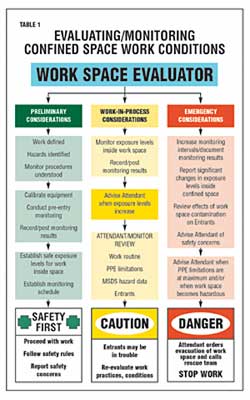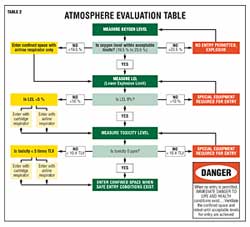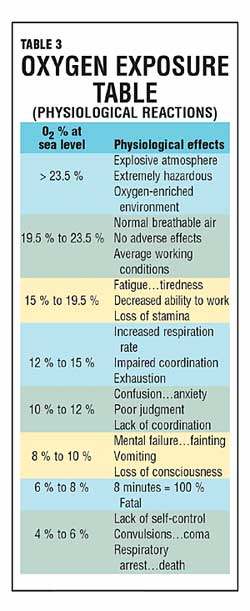Confined Space Entry, Part 4
The atmosphere evaluator's role is generally routine unless contamination levels are increasing or entrants' work attitude indicates oxygen deficiency.
- By Stephen V. Magyar, Jr., MBA, CSP
- May 01, 2006
 THE most critical element in ensuring that work inside confined spaces is completed safely is the ability to anticipate safety problems before they become life threatening. Hazard evaluation can be as simple as evaluating changes in work attitude or as complex as evaluating environmental conditions.
THE most critical element in ensuring that work inside confined spaces is completed safely is the ability to anticipate safety problems before they become life threatening. Hazard evaluation can be as simple as evaluating changes in work attitude or as complex as evaluating environmental conditions.
Special training in identifying the physiological effects of confined space work exposure and in the use of monitoring equipment is necessary. The timely evaluation and interpretation of information collected ensures that confined space work can be completed without incident. The atmosphere evaluator or monitor is the team member who provides the early warning signs of danger.
Monitoring responsibilities are generally assigned to a single employee who monitors several work spaces in close proximity to one another. Monitoring responsibilities also can be assigned to the Attendant when only one or two work spaces are involved. When joint responsibilities are assigned to a single employee, all duties of the Attendant & Monitor must be safely discharged. The Entrant has the right to veto the "dual responsibility assignment" if safety considerations are an issue.
The duties of the Monitor can be divided into three main areas: preliminary considerations, work-in-process considerations, and emergency considerations. (See Table 1.) It should be noted that no work in confined spaces can begin until all preliminary considerations are addressed and satisfactorily resolved.
 Preliminary Considerations
Preliminary Considerations
All work to be done inside the work space must be communicated, and the potential hazards inherent within the work routine must be clearly understood by all team members. This is particularly important when chemicals or solvents are used inside the work space. In such cases, evaporation rates, permissible exposure limits, flammability, toxicity, and other potential hazards may exist. The signs and symptoms of overexposure must be discussed, protective equipment limitations must be reviewed, and safety procedures must be explained.
Escape and rescue procedures in the event of an emergency also may be a safety concern when heights or limited access openings are involved. Team members must understand their roles in completing a safe evacuation and/or rescue. In addition, the environment immediately surrounding the work space must not cause a safety problem inside the work space. Entrance/egress from the work space must remain open, required safety equipment must be used, and the physical condition of all Entrants must be observed/evaluated to ensure their ability to perform work.
These issues must be evaluated by the Monitor to ensure that all potentials for danger are reviewed before work commences. Discussion of safety concerns among all team members will ensure anticipated hazards are reviewed and resolved before work begins.
Monitoring procedures must be established whenever contamination inside the work space is present. The frequency of monitoring must be based on the potential for continued and/or increased contamination. Instrumentation that measures oxygen level, lower explosive limit (LEL), and toxicity, in that order, must be used to evaluate contamination levels. All monitoring equipment must be calibrated according to the manufacturers' specifications before any measurement is taken.
Monitoring results must be posted at the work site where they can be viewed by all members of the work team. Safe exposure levels for work inside the work space must be established and, when required, use of personal protective equipment must be based on the anticipated hazard and exposure level. Team members must understand and be able to interpret monitoring data. When monitoring procedures are not followed or when exposure levels exceed established safe levels, all work must stop, and the work space must be evacuated.
Work-in-Process Considerations
Monitoring contamination is generally a routine assignment unless contamination levels are increasing or the work attitude of workers inside the space indicates oxygen deficiency.
Increases in contamination usually are triggered by lack of ventilation, "contamination pocketing," or introduction of new chemicals or processes. The Attendant must be advised whenever contamination levels inside the work space begin to increase.
Table 2 provides an outline of exposure levels permitted for oxygen, LEL, and toxicity. It should be noted that permissible levels for LEL and toxicity will vary depending on the chemical or solvent being used inside the work space. When oxygen levels exceed 23.5 percent, the atmosphere is enriched--and there is no protective equipment that can provide adequate protection from the hazard. The work space is explosive and must be evacuated immediately.
 When exposure levels for LEL and toxicity are at 5 percent or below of permissible exposure levels for the chemical or solvent, cartridge respirators can be used. If exposure levels rise above the 5 percent level, it may be necessary to consider other protective equipment.
When exposure levels for LEL and toxicity are at 5 percent or below of permissible exposure levels for the chemical or solvent, cartridge respirators can be used. If exposure levels rise above the 5 percent level, it may be necessary to consider other protective equipment.
When purging with fresh air is used to reduce contamination, care must be taken to ensure that external contamination is not drawn into the work space via deluge air supply systems or air intakes. Carbon monoxide from forklifts, gases/vapors from plating operations, welding fumes, or other contaminates should not be exhausted into the work space.
"Contamination pocketing" occurs when solvent vapors, gases, or other byproducts of work inside the space gather in corners and cause higher contamination levels in a few work areas. These conditions will manifest themselves in complaints about ineffective protective equipment and/or changes in work attitudes of the Entrants. Communications between the Entrants and the Attendant and/or Monitor usually will provide an early warning when this is occurring. A complete review of MSDS hazard data and/or an evacuation of the work space may be ordered by the Attendant to ensure the safety of all Entrants.
If it is determined that new chemicals or processes have been introduced into the work routine, a "stoppage of work" must be ordered immediately, and a complete investigation of "what went wrong" must be completed. When this occurs, a new work plan must be developed, and all monitoring procedures must begin with the preliminary considerations.
 Emergency Considerations
Emergency Considerations
Emergency conditions exist inside the work space when concerns for the safety of the Entrants increases. This becomes an issue when exposure levels for LEL and toxicity rise above 5 percent of permissible exposure levels and/or when oxygen levels approach 19.5 percent. Monitoring must be increased, and additional changes in exposure levels must be reported to the Attendant. Communications between Entrants and the Attendant and/or Monitor also must be increased to determine physiological effects on the Entrants.
Table 3 outlines the effects of reduced oxygen levels. Significant changes in the quality of communications with the Entrants can provide a signal that oxygen deficiency is a concern. Excessive exposure levels also will produce complaints about ineffective protective equipment, headaches, dizziness, and tiredness. When plant-supplied air is used by Entrants to perform work, the air must be monitored for carbon monoxide level (must be less than 20 percent). Traps also must be provided to collect particulate and condensate that may be present in the air lines.
Special protective equipment also may be required when caustics, acids, or other health-hazardous materials are present. When maximum protection levels for the protective equipment provided are attained, the Monitor must advise the Attendant, and an immediate evacuation of the work space must be ordered. The Rescue Team also must be summoned to assist with any rescue that may be required.
Conclusion
The principal role of the Monitor as a Confined Space Entry Team Member is to alert the Attendant of all impending concerns that might affect the safety of the Entrants. When work is properly monitored and safety issues are controlled, it should never be necessary to stop work because a life-threatening condition exists.
This article appeared in the May 2006 issue of Occupational Health & Safety. Part 5 in this five-part series will be published in the June 2006 issue.
This article originally appeared in the May 2006 issue of Occupational Health & Safety.